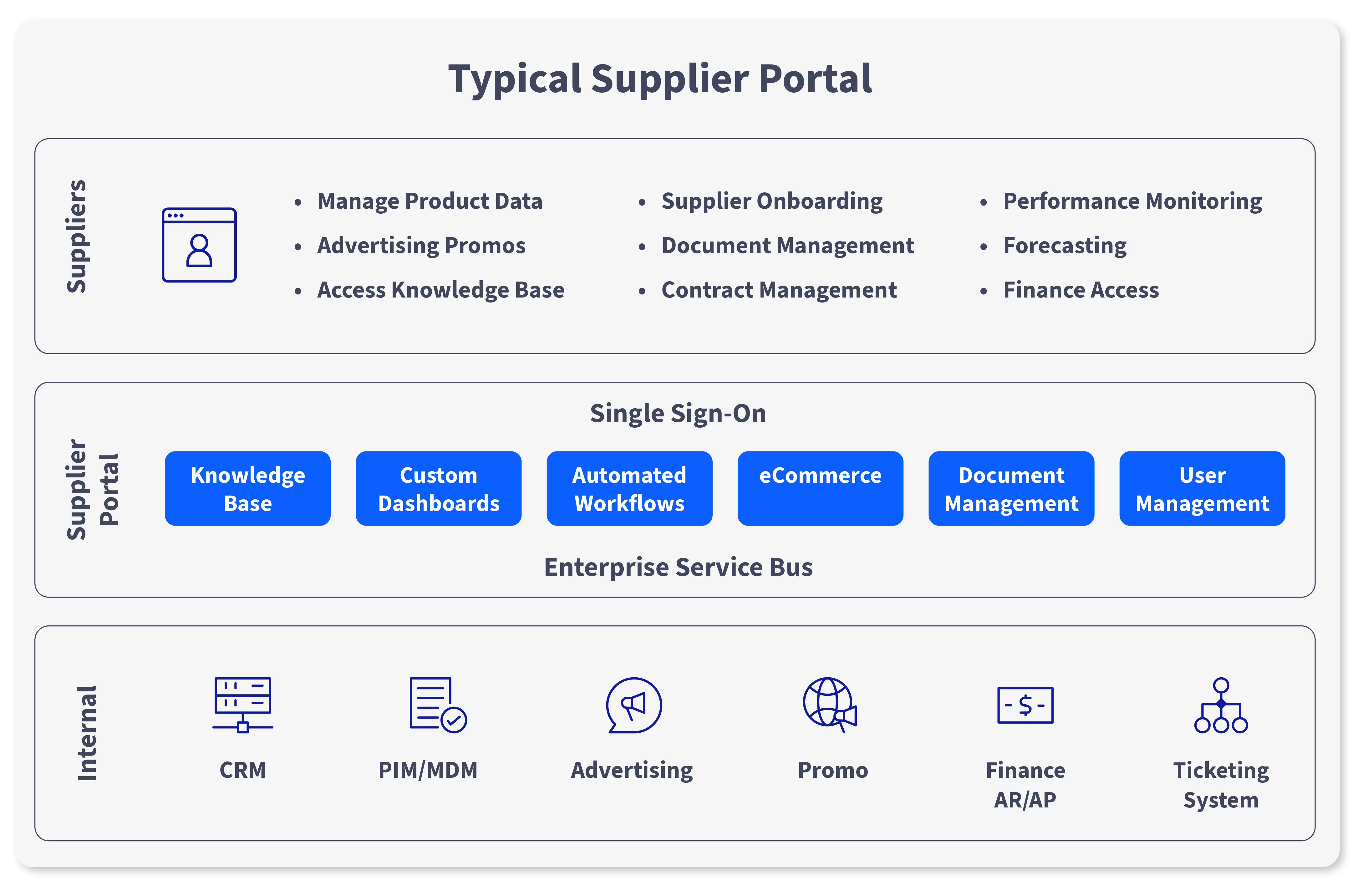A supplier portal, sometimes called a supplier platform or a vendor portal, is a solution that acts as a digital home for your supply network. Supplier portals provide visibility into everything from invoicing and payment to supplier data and status. They act as a one-stop shop for relationship management, capable of delivering value to your entire business in a number of ways.
Here’s a look at the building blocks every supplier portal should have and how to choose the right one for your needs.
Benefits of a Supplier Portal
There’s no doubt that the adoption of business-to-business (B2B) self-service commerce has expanded rapidly, particularly since the pandemic and related supply chain disruptions. In fact, the global B2B eCommerce market is estimated to reach USD 33,317.37 billion by 2030, increasing at a compound annual growth rate of 20.2%.
But there are more aspects to B2B Commerce than you may have considered. When most companies think of eCommerce, they view it in the context of a better and more efficient way to sell to their customers, whether they are consumers or other businesses. However, to bring even greater efficiency to their organizations, large retailers, wholesalers, distributors, and manufacturers are also looking for more effective methods of supplier management — like, for example, through a supplier portal.
Main benefits of a supplier portal include:
- Digitization & Automation: Digitizing business processes is an essential success factor in today's market – and a prerequisite for eliminating manual tasks. A supplier portal allows you to digitize and automate procurement and payment processes, improving data accessibility and ensuring digital accuracy at every turn.
- Communication & Visibility: When every supplier record, purchase order, request, and conversation exists in a single place, communication is faster and clearer. Plus, it’s easier to review and respond to supplier quality issues.
- Efficiency & Optimization: Whether you’re managing the onboarding of new suppliers or improving invoice processing, a supplier portal allows you to start re-defining your existing workflows to boost efficiency across all your supplier relations. This includes offering self-service capabilities for each supplier profile.

Most Important Building Blocks for a Supplier Portal
Your supplier portal should allow you to speed up processes and communicate fast and efficiently, enabling you to quickly adapt to changing market dynamics. The following building blocks will help you accomplish this:
1. A self-service knowledge base that makes it easy for your suppliers to understand your purchasing process and the kinds of benefits they can realize by doing business with you.
2. An easy and efficient self-service onboarding process for new suppliers.
3. The capability to upload product-related data to your MDM/PIM database.
4. The ability to request quotes, capture order responses, and track their status to see if an order has been accepted or rejected.
5. Access to your campaign planning system and calendars to create, manage, and assess how products and promotions are performing.
6. Access to timely and relevant financial information such as Accounts Payable status, invoice tracking, performance against contracts, etc.
7. Visibility into EDI transactions to showcase metrics like fulfillment time and accuracy.
8. The ability to automatically route requests for information or approvals to the correct department or individual and to receive real-time status updates.
9. Document upload and management for regulatory and supplier health-related content.
10. A single simplified sign-on that gives suppliers access to any systems with which they need to interact.
11. Strong user and identity management that enables access control for each supplier account.
Although a supplier portal may be functional without any one of the above building blocks, it may not deliver everything you need to reap the potential benefits. If you want to get the most out of your supplier portal, search for a software solution that unites all of these.
Choosing a Supplier Portal: What to Look For
When looking for a supplier portal, you want to ensure you have the right functionality for both present and future needs. Make sure to prioritize:
Scalability
You may prefer to start small by making sure your solution offers the basics, such as self-service onboarding for new suppliers or a supplier knowledge base. However, your portal needs to be able to easily scale over time to accommodate more suppliers and applications. Pay attention to any additional costs you may incur when adding more users or additional functionality.
Flexibility
It's easy to be dazzled by a features demo of portal solutions. But you also need to be sure your portal platform can adapt to your needs as they change in the future. Ask your IT experts to evaluate the proposed solution to make sure it fits in with your overall digital ecosystem and offers the tools to grow.
CMS
Offering accurate and up-to-date information directly to suppliers is essential if you want to facilitate communication and collaboration. Content management capabilities help you provide a single repository for information by enabling you to create and manage content, such as web pages, blog posts, and wiki articles.
Digital Asset Management
We may live in a largely paperless world, but you'll still need to manage a range of different content types, including spreadsheets, PDFs, images, videos, Word docs, forms, government and health certifications, shipping documents, and more.
Search
An enterprise-level search capability is essential to help your users navigate your portal and quickly find the information they need. For example, refining search results on FAQ pages and knowledge bases using filters, such as categories, tags, and other metadata attributes, will greatly improve the user experience, helping suppliers to handle and resolve more straightforward issues on their own.
Personalized User Dashboards
Different categories of suppliers and individual users need to access information unique to their product type, user type, or vendor status. Your portal should be able to support dashboards that make it easy for every user account to find and view general information, role-specific data, and more. For instance, someone in your supplier's accounting department will need a much different view than someone in the sales or logistics team.
Integration Capabilities
A good supplier portal enables integrations with external technologies through native connectors, APIs, and other integration tools. Bring together existing systems to surface information such as the status of purchase orders, inventory levels, or number of open tickets, all from within the portal.
Automated Workflows
One of the advantages of an enterprise portal platform is the ability to create automated workflows to optimize routine processes. For instance, you can create a workflow to capture and track the progress of purchase orders, setting an SLA to trigger automatic reminders for suppliers if there is no response within five business days. And in the case of an invoice requiring updates, suppliers should be able to request changes directly within the portal, eliminating the need for phone calls or email communication.
User Experience Management
It’s critical to create a positive user experience that includes logical journeys with simple navigation. Ideally, your supplier portal unites all the sites and systems that suppliers and internal teams use under one login and password (single sign-on), helping both parties save time. In addition, the portal platform you choose should offer low-code capabilities to business users, allowing them to make changes that affect the user experience without needing to involve IT teams.
Get Started with Your Customized Supplier Portal
As the global supply chain grows more complicated and business partnerships increase reliance on self-service solutions, a good supplier portal will become particularly important. Aside from improved visibility and communication, these solutions put you in charge of real-time supplier relationship management, making the supplier portal an important channel to digitize all relevant interactions and monitor them on a single platform.
An effective supplier portal, therefore, needs to sit on top of your existing systems as a window to what is happening on the back-end. To achieve this, build your supplier portal with a flexible solution, like a digital experience platform (DXP).
A DXP is enterprise software that provides the foundation for companies to deliver connected, contextualized digital experiences across multiple touchpoints for the entire customer journey. DXPs provide capabilities out-of-the-box to support and accelerate the composition, management, and optimization of digital experiences. But what sets DXPs apart is their ability to integrate with other technologies and act as an interface to surface relevant data.
Ready to see for yourself? Here’s what a Supplier Portal built with Liferay DXP can do: www.liferay.com/supplier-portals.


